Well, it's January and that means that I check out a birding trade show. In the past, I was at Bird Watch America, but this year I'm in the Birding and Nature Show at AmericasMart. I'll most likely be tweeting up a storm on (hopefully) new and interesting product. If you're interested, you can follow that on Twitter under Birdchick. I'm sure some of it will work it's way here but mostly it will go to Twitter and eventually Birding Business. Oh and speaking of Twitter, if you didn't see my link to One Lazy Duck, follow that link, you will chuckle.
Turkeys Chasing A Laser Pointer
What more do you need to know? [youtube]http://www.youtube.com/watch?v=4_czuaykWPw[/youtube]
Metaphor For Marriage?
Below is a relative approximation of me getting out of bed to go birding while Non Birding Bill is still sleeping. I'm the gentoo penguin and bill would be the seal: [youtube]http://www.youtube.com/watch?v=cdPGXClOE5g&feature=player_embedded[/youtube]
Twin Cities Snow Shoeing
I have accepted the snow and have taken to snowshoeing. Partly because my park got a whole bunch of snowshoes this winter and I'm doing some programs one on January 21 and the other on February 19. I need to practice because I have a tendency to walk with my toes out, which inevitably leads to me stepping my shoes and tumbling ass over tea kettle into the snow. I was out with a bunch of rangers at the Minnesota Valley National Wildlife Refuge last week and it was so cool. We found just about every textbook thing you could find on a snowshoe hike: coyote tracks, otter tracks, rodent tracks that end with feather prints and...

...even a fresh antler shed! That's a couple of my fellow rangers in the photo. The antler had six points on it. That's pretty incredible when you consider how deeply this refuge is embedded in the urban Twin Cities. This shed was so fresh, it hadn't been chewed by any mice yet and it still had a bit of blood on the spot where the antler was attached. Too cool! I think it wasn't even an hour old.

After the snowshoe, I hung out at the feeders at the Minnesota Valley National Wildlife Refuge. Check out all the spots of red, the cardinal activity was off the charts. There were even more in the above photo, but at least three were cropped out.

I find comfort in watching the steady stream of activity at bird feeders. Little things like blue jays filling their crops so full with peanuts that you can see the overflow in their open beaks.

I was surprised to see a white-throated sparrow hanging out at the feeders, but for whatever reason, this bird didn't go further south. It's got a good food supply and cover at the refuge. If it can dodge the local sharp-shinned hawk, it just might make it. Here are some other birds visible in the falling snow around the refuge:

Female cardinal (with a female house finch down at the bottom).

Male house finch.
Things To Look Forward To In January!
I've updated my appearances page and I have some fun things to look forward to this year. One thing that is coming up quickly is that I'm going to be a guest with the Rockstar Storytellers this Sunday at the Bryant Lake Bowl. I'll be performing with talented local actress Zoe Bentson my The Woman Who Could Talk To Bird. A true story based on my days working about the bird store and a woman who claimed she could psychically talk to birds. There's also the Birds and Beers at Joe's Garage to watch the massive crow roost and some snowshoe programs with my National Park.
And for those who would like to get out in the snow, I'm leading a couple of Moonlight Snowshoe walks at Crosby Park. I'll bring my scope and we'll take a look at the moon and maybe a few stars. We'll also listen for owls and get some GREAT exercise. The dates are January 21, 2011 and February 19, 2011 from 7 pm - 8:30 pm. If you need snowshoes, you can borrow them from the park, but you need to call and reserve them. It is a free event, but we ask that you call and sign up so I can call you if we have to cancel due to something like a blizzard or if we have more people than I anticipated, I can corral an extra ranger to come along on the walk. Call 651-293-0200 to sign up!
I Need A Cleansing Cardinal
After all the talk of the dead bird reports, I need to savor the birds right in front of me. So, here is a random cardinal photo I took during our snowshoe outing yesterday:

Bird Die Offs
There are more bird die offs being reported--now in other countries. I have mixed feelings about this. On the one hand, I'm irritated that every dead flock is being reported with added commentary (like CNN's Anderson Cooper interviewing Kirk Cameron about the birds kills) asking if this is a sign of the "end times." On the other hand, I'm happy that flocks of dead birds are reported and that people know this happens. Let me be clear about one thing: THIS IS NOT THE END TIMES. This happens A LOT. We just don't hear about it. To give you some perspective, millions of birds (of several species) are killed by windows, cell phone towers, wires, free roaming cats and vehicles every year. The numbers may not be seen, the dead birds are often eaten in the night by opportune scavengers.
According to Bird Conservation Network: at least 100,000,000 birds are killed and even more are injured every year across North America by collisions with windows.
An estimated 5,000 to 10,000 birds, mostly lapland longspurs were killed on the night of January 22, 1998, at a 420 foot tall communications tower in western Kansas--cause for serious concern and panic...especially since this sort of thing happens a lot and few people hear of it.
According to US Fish and Wildlife: At least 4 million and as many as 50 million birds are killed annually in tower collisions, the US Fish and Wildlife Service estimates. Here is a GREAT document from US Fish and Wildlife about birds and collision injuries.
From my perspective, incredibly common birds like red-winged blackbirds, grackles and starlings that have a tendency to move around in tight knit flocks of hundreds of birds getting wiped out by colliding into power lines, vehicles, each other via panic from fireworks is a concern but not a panic.
Cause for panic is BP trying to say that the Gulf of Mexico is fine and only 2000 birds were killed. There were more, they are not easily recovered in the water and we have yet to see how wintering ducks are going to fare (not to mention how many birds their response teams killed by driving over their nesting colonies). Will there be enough food for years to come. I'm still far more concerned with the BP big picture than I am with the Arkansas Aflockalypse.
If you doubt that millions of birds are killed every year, here's a great example. On September 11 of last year, they put up the Tribute of Light for the fallen Twin Towers and thousands of birds were trapped in it. New York is on a major migratory bird route. The winds were right for fall migration and birds were on the move. With the tower lights on, they were attracted and couldn't leave. The lights had to be turned off several times to get the birds to leave rather than spending the night trapped in the lights, exhausting their energy resources and possibly killing them. This is just one night in one spot. That to me is cause for panic. Thousands of birds of several different species. Many of these birds are the insect eating kind, not the "pest kind" like blackbirds who raid fields. Here's a video of the event:
[youtube]http://www.youtube.com/watch?v=EZAQSw0qCAI&feature=player_embedded#![/youtube]
So, listen to those news reports, don't freak out that the end is near but do find ways that you can help solve these collision problems in your neighborhood and city.
Aflockalypse Now?
Good grief! First we had the story of the 3000 - 5000 dead birds in a one mile area in Arkansas...and now we have another report of 500 birds dead on Louisiana. What the heck could be going on? Flockmaggedon?? Here's my take: I agree that the New Year's Eve incident in Arkansas was probably the result of fireworks startling a sleeping flock and that birds either ran into each other or into houses and trees resulting in collision trauma. The reports say that the collision injuries were in the front of the birds--as if they flew hard into something. If the trauma was caused from their fall from the sky, then the necropsy would show the trauma on different sides of each bird, as each bird would fall and hit at different angles. So, barring that the red-winged blackbirds, grackles, cowbirds and starlings flew into an invisible alien spaceship, I think the fireworks theory is plausible.
Let's take a look at some images of blackbird flocks. I went into Google and searched for "blackbird flock" and "starling flock." They're flocks can look similar:
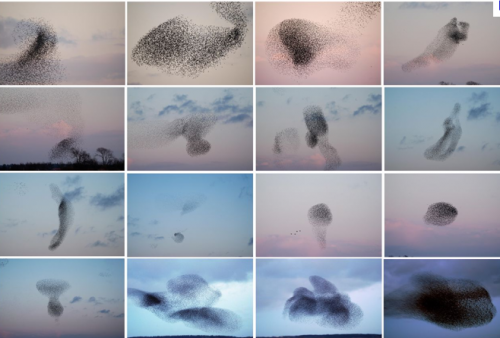
I did not take any of these photos. These are all flocks of blackbirds. This gives you an idea of what those roosting flocks can look like. If you've never seen a winter roost starling flock or a blackbird flock, it is a strange presence in the sky. It reminds me a bit of the eeriness of an Aurora Borealis. Here's another flock photo:
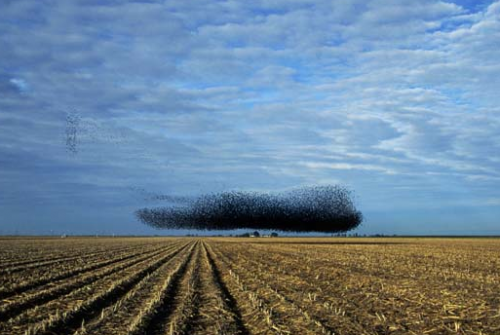
Again, I did not take this photo, but I found via Google Image Search. Look at how tightly packed those birds are. That is a group out during the day, in the wide open. They can move and swirl and function more as a whole without flying into each other in the daylight. At night, in a full blown panic, that many birds will run into each other. If they were roosting, they were probably low to the ground to begin with. If fireworks were going off overhead, they sure as heck would not fly up, they would try to fly below it. In the dark and in a panic, they'd run into each other, trees, poles and buildings.
Now, here is a photo of the dead blackbirds in Louisiana:
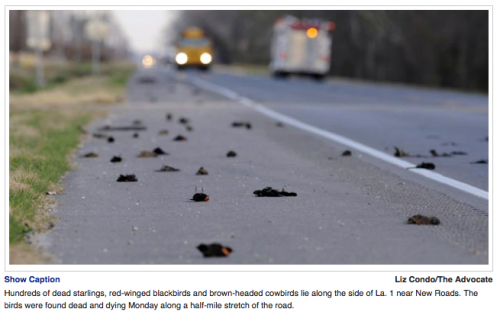
This photo is from The Advocate. Keep in mind how tight those blackbird flights can be. Now, note the blurred vehicles in the above photo. See the bus? I wonder if semis also come down this road. I think a flock of blackbirds flew hard into a large vehicle and died. It's happened before. I remember reading about a case in the 1990s. It doesn't even have to have happened at night. It could have happened at dawn or dusk. The startling factor for the blackbirds may not have been fireworks, but a Cooper's hawk. This probably would have gone unreported had it not been for the Arkansas story.
Mysterious things happen to large flocks of birds,they don't get quite the media play as this story did. Here's a story you may have missed about several hundred turkey vultures found floating just off the Florida coast near the Keys from last November. It's sad that we lost a lot of blackbirds. Is it cause for concern and should we try to find out the reason? Yes! Should we panic for the coming apocalypse? No.
And I end this with a starling flock video: crazy stuff:
[youtube]http://www.youtube.com/watch?v=XH-groCeKbE[/youtube]
Last night on Facebook people were posting vague links other possible die offs, but I could find no news organizations reporting on them.
Random Lineated Woodpecker
Going through photos of last year and I found a Panama woodpecker that I didn't post:
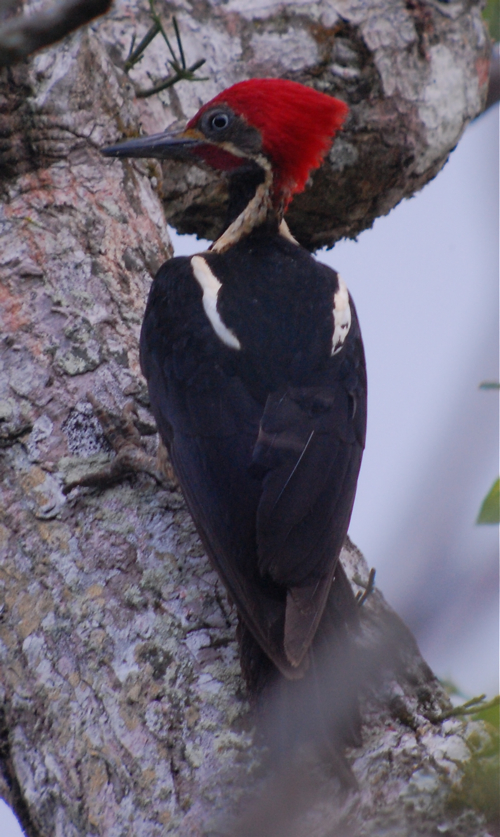
This is a Central American cousin of the pileated woodpecker and about the same size.
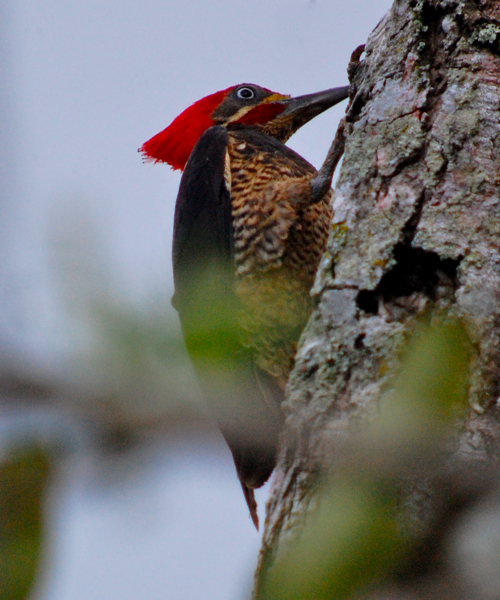
I ended up seeing them on field trips based both from Canopy Tower and Canopy Lodge. They weren't super common but, like a pileated, if you hang out a bit in the places they are most likely to be found, you'll see one.
Thousands of Dead Blackbirds in Arkansas
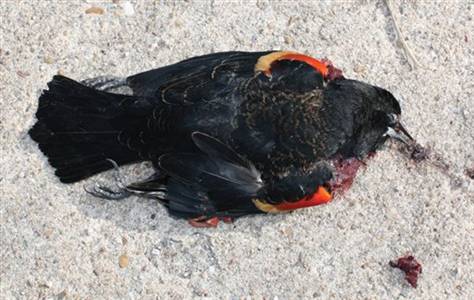 The news wires are buzzing with a story of thousands of blackbirds (mostly red-winged with a few grackles mixed in) literally falling from the sky in an Arkansas town on New Year's Eve.
The news wires are buzzing with a story of thousands of blackbirds (mostly red-winged with a few grackles mixed in) literally falling from the sky in an Arkansas town on New Year's Eve.
The Arkansas Game and Fish Commission said its enforcement officers began receiving reports about the dead birds about 11:30 p.m. Friday. The birds fell over a one-mile area of the city, and an aerial survey indicated that no other dead birds were found outside of that area, officials said.
Commission ornithologist Karen Rowe said that similar events have occurred elsewhere and that test results "usually were inconclusive."
The birds showed physical trauma, said Rowe, who surmised that "the flock could have been hit by lightning or high-altitude hail."
The agency also said another possibility is that New Year's Eve revelers shooting off fireworks in the area could have startled the birds from their roost and caused them to die from stress.
It's doubtful the birds were poisoned, Rowe said, "since it only involved a flock of blackbirds and only involved them falling out of the sky." She said a necropsy is the only way to determine if the birds were poisoned.
This is an interesting incident. I agree with the ornithologist that since the birds fell in a concentrated area and appear to be species that would be in a mixed winter flock, something in the air happened and injured them. Could it have been lightening or hail from the storms that blew through? Arkansas was hit with tornadoes that night. Or could it have been fireworks from New Year's celebrations? I guess it will depend if they find burn marks on the birds.
This reminds me of the time I went to the first Ivory-billed Woodpecker Festival in Brinkley, Arkansas in 2006. When we arrived to set up our booths, there were huge flocks of thousands blackbirds all over the area which we thought was kind of cool. Their flocks would wheel and spin in the sky, forming fluid and temporary shapes in the sky. This was a wintering area for several icterids including red-winged blackirds, grackles and cowbirds. Some of the flocks were coming in to land on the trees surrounding the parking lot for the festival's meeting area at the convention center and we watched as they would dip onto the trees and take off for the sky again.
Suddenly, we heard some banging and I saw some young men with guns firing at the blackbirds landing in trees around the parking lot. The also set bottle rockets off towards them. We marveled that a festival would be so naive to think that birders would understand shooting birds outside of a bird festival. We were also baffled that they did not see the beauty of the blackbirds swarming in odd shapes in the sky.
I went to the festival's contact to talk to her about it. She was discussing last minute details with the mayor of Brinkley. I told her that she might want to curb the firing squad on the blackbirds because birders could take offense to that sort of thing happening at a bird festival.
The mayor leaned towards me and said in his southern drawl, "This ain't no blackbird festival, this is an ivory-billed woodpecker festival."
I tried to explain that birders liked all sorts of birds and would appreciate the spectacle of the multitude of blackbirds. Both were skeptical and explained that no one would care for the smell of the droppings or the mess of bird poop in the morning.
Well, birders did not find bird poop in the parking lot at the festival the next morning...they found dead birds littering the ground instead. Couple that with what appears to be a non existent woodpecker, you can see why that festival doesn't happen any more.
Here's a link to a great video of starlings coming in to roost on the trees. There are so many birds, the trees literally bend under the flock's weight.

